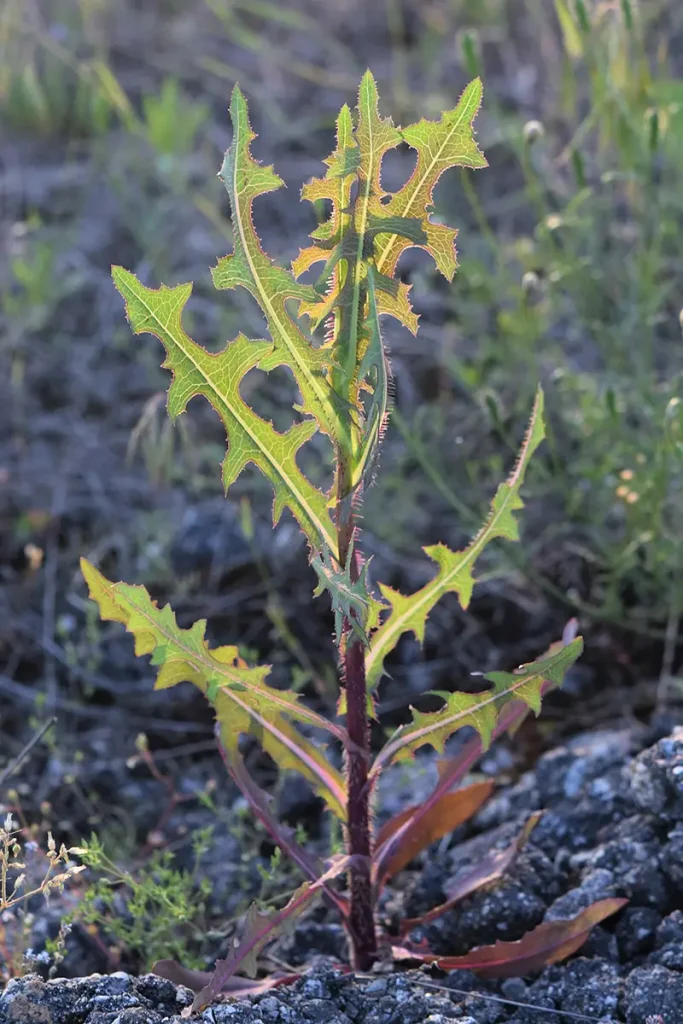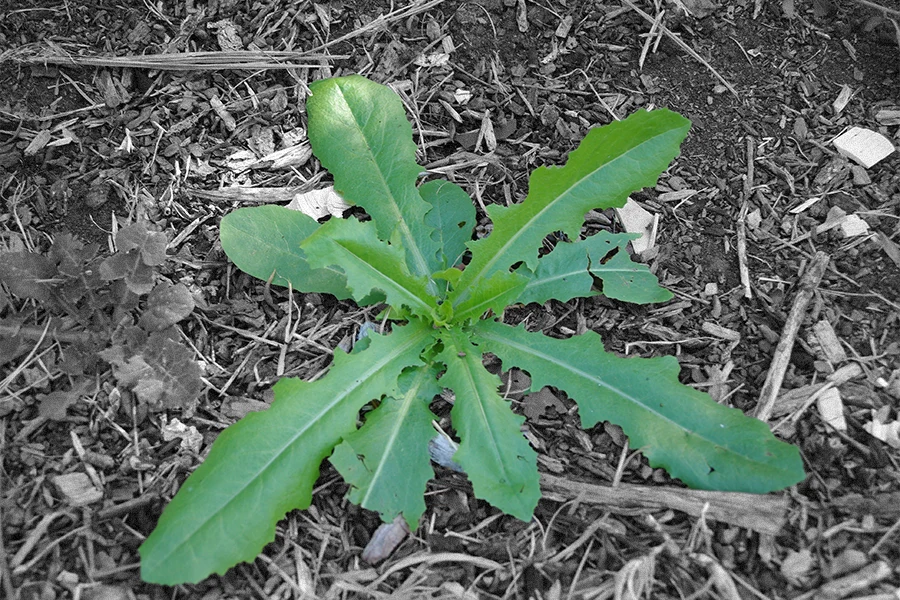With the rising popularity of herbs for traditional and recreational use, many are seeking out herbs known for their entheogenic properties. Entheogen is a word used to describe substances that occasion spiritual experiences—like many classical psychedelics. But, not all psychoactive herbs are entheogenic. Instead, they may have other medicinal properties that warrant recognition. Wild lettuce is one of those herbs. Wild lettuce is a very common herb that was once a very important plant for many: it’s used as an ingredient in salads, as medicine, and in myth.
Wild lettuce is an annual or a biennial plant that grows in full sunlight to light shade along riverbanks, tree lines, roadsides, disturbed areas, open pastures, fields, gaps in walls, basically wild lettuce can grow anywhere that is sunny enough and well drained. Like many plants, the origin of wild lettuce is debated, however today, different varieties of wild lettuce grow in North and South America, Africa, Asia, Europe, and Australia, leaving Antarctica as the only continent where it does not grow.
READ: What Does Wild Lettuce Look Like? A Forager’s Guide

Wild lettuce is known by many names. The prominent latin names are Lactuca virosa and Lactuca canadensis. Lactuca srariola, or Prickly wild lettuce is a variety also used, but is differentiated by the prickly underside spine of the plant. Some of the most common names of wild lettuce include Opium lettuce, Tall lettuce, Horse thistle, and Bitter lettuce. Afir Muhammad in a review, “Traditional Use Of Kahu,” shares other dialects and languages that are not as widely represented including; Tukme Kahu (Persian & Urdu) Bazrul Khas (Arabic) Kahu, Salad Beej (Bengali), Thridox (Greek), Guado, Lattuga (Italian), Kahu (Punjabi), Sallattu Virai (Tamil), Kavu Vitula (Telugu), and Kahu ke beej (Hindi).
Depending on the ecosystem wild lettuce grows in, it produces different variations: The plants adapt to their habitat, both in the short-term and the long-term. In the short term, plants in different environments may produce different levels of botanical compounds. In the long term, different species adapt to thrive in certain regions. I believe in approaching wild lettuce not only for the information you read about it, but also, from a relational perspective—engaging with these plants means becoming aware of the ways we influence our environment and the ways our environment influences us.

History of Wild Lettuce
Wild lettuce has been prolific throughout the world and so prominent that it shows up in literature in different places spanning from 2,000 BC all the way to the nineteenth century. Poems were written about wild lettuce in Sumeria, specifically songs about love. In Egypt, the god of virility, Min. Wild lettuce had an association with Min due to the milky white substance that is brought forth by the leaves and stem that they thought of as an aphrodisiac, likening it to semen. It also shows up in a few variations of a story having to do with Adonis and Aphrodite, interestingly enough, it was more associated with sexual inability to the Greeks. Wild lettuce has been used in multiple systems of medicine including Ayurveda, Unani Tibb, a variety of Native American healing traditions, European folk medicine, and homeopathy.
Is Wild Lettuce Psychedelic?
Wild lettuce is gaining popularity as continued reclamation of healing practices and perspectives are emerging. Many people seek out herbs with psychoactive effects to aid in the process of healing. The question often comes up: Do all medicinal plants have a psychedelic effect—or is there something that eludes current scientific approaches that gives the plants their spiritual and energetic influences? István Ujváry says that “Apart from the (user-)reported narcotic-euphoric effects resulting from recreational use, there is scant contemporary information on the (psycho)-pharmacological properties of either the latex or its pure ingredients.”

In an interview with the co-founder of school of evolutionary herbalism, Sajah Popham said, “It is interesting how in the world of people who are really into psychotropic plants, oftentimes it is listed as a psychotropic plant.. It is one of those plants that people try to get high with and I am not totally sure. You would have to take a lot of it and it is tough, it’s really bitter.” He goes on to discuss that the majority of common herbal medicines are not classified as entheogenic and states, “if we were to classify it, I would say it is a feeble narcotic, meaning it can relieve pain. I would not classify this plant as an entheogen in any way, shape, or form. I would say that in large enough doses it can be mildly narcotic. It is a sedative for the central nervous system.” Based on the testimonies of herbalists and researchers, no psychoactive compounds exist in wild lettuce. From our current understanding wild lettuce would not be considered psychedelic, although further research is still needed to fully understand the plant’s effect.
How to Grow Shrooms Bundle
Take Both of Our Courses and Save $90!
How to Prepare Wild Lettuce for Use
The first step to learning to prepare wild lettuce is by properly identifying it. Be sure to educate yourself on how to identify it prior to attempting to harvest because it does have look alike plants in many areas that it grows. Wild lettuce is a wild edible that is great for salads, soups, and sautees. It can also be prepared as a tincture. In the interview with Sajah, he shared, “I prefer only preparing it fresh in a higher percentage alcohol. It likes 60% alcohol in order to extract it optimally, as concentrated a ratio as you can. I have usually done it as a 1:1 fresh tincture in about 60-70 percent alcohol.”
When preparing the tincture of certain plants it is more or less important if you use the fresh or dried herb. Wild lettuce is an herb that is more effective if prepared fresh due to the presence of the white milky substance it exudes. A tea of the herb is also widely used although it too is ideally made from the fresh herb instead of the dried herb that loses a lot of its potency. Typically one-two teaspoons of herb is used per cup of tea. If working with wild Lettuce specifically for pain relief, see what your local herbalist suggests as every case is unique and guidance on the correct amount is what will lead to the most effective use of wild Lettuce. In Unani Tibb medicine, the herb also can be made into a powder and mixed with honey, which is said to reduce the potential adverse effects. Another preparation is lactucarium, collected secretions of wild lettuce. It was used in medicines like cough lozenges and syrups—but we won’t get into the process of preparing lactucarium today.
Benefits of Bitter Lettuce
Wild lettuce is well documented in many places around the world for its traditional use for its anodyne (pain relieving) properties. The parts used are the milky substance that comes from the leaf and stem, dried leaves, oils, and seeds of the plant. It is a central nervous system depressant that can help to alleviate musculoskeletal tension, spasms, has a sedative effect on the mind, and relieves headaches that are specifically caused by intense summer heat. Wild lettuce has been used alone and in combination with other plants to soothe symptoms of insomnia. Wild lettuce also has diuretic properties, aid in removing fluid build up in the body. In the respiratory system, it can relax tension that is obstructing breathing, specifically when it is a hindrance to sleep.1
Energetics of Wild Lettuce
When working with herbs from an herbalist perspective, it’s important to identify how the herb will interact with you. This brings us to a little discussed topic of herbal energetics. Herbal energetics is the ability to consider the shift in temperature, moisture, and tension that takes place in the body when using an herb. One thing that is important to consider is how hot, cold, wet, or dry a plant is and to what extent. In the case of wild lettuce, it is considerably cold and drying. No matter if we are exploring wild lettuce for the recreational or medicinal virtues, considering the temperature, moisture, and effect a plant has on tension allows you to work with it in a relationally harmonious way. This helps to get out of the pattern of utilizing an allopathic and commified approach in which we take the plant and “use it.” It allows us to consider how the plant will interface with our bodies based on our personal make up. Are you hot, cold, wet, and dry? If you can begin to develop a relationship with yourself based on these fundamental qualities then it becomes easier to understand what plants are best for you when you begin to see them based on these qualities. The majority of negative effects that people experience from herbs is because of the lack of knowledge around contraindications is due to an incompatibility of the person and the herb.
Potential side effects, Risks, & Drug Interactions
Wild lettuce is in the Asteraceae family and is a type of lettuce. A small population of people have allergic responses to certain types of lettuce and a variety of plants in the Asteraceae family. If a known Asteraceae or lettuce allergy exists, it might be best to seek out other plants. Wild lettuce is contraindicated for general usage while pregnant. Wild lettuce is a central nervous system depressant so precautions should be taken if you are taking sedative medications. The sedative medications in combination with wild lettuce can create a more pronounced effect of sleepiness. Avoid wild lettuce if excess sleepiness could cause potential harm while using sedative medications. In a study on wild lettuce and its toxicity the patients had a variety of symptoms. A major consideration that arose when reading this article is that it is not confirmed that the patients properly identified the plant, harvested it at the proper time, and the dosage of the herb eaten was in undetermined large amounts. More studies on wild lettuce are needed to a proper conclusion on its potential toxicity. The lactucarium that comes from wild lettuce is made from the milky white, latex-like substance extracted from the plant. Calling it a white “latex-like” substance can be misleading—it is not latex. If you have a latex allergy then it does not apply to wild lettuce.
- Note: This section draws upon Allen’s personal and professional experience as an herbalist. ↩︎
Interested in having a psychedelic experience, but don't know where to start? Get our definitive guide on trusted legal retreat centers, clinical trials, therapists, and more.



